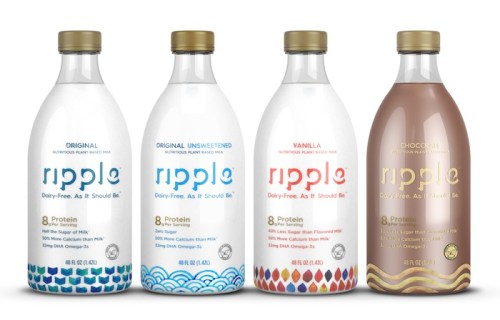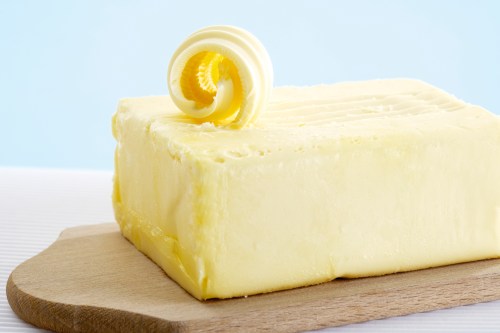There’s a new milk that’s about to start vying for inclusion in your coffee cups and smoothie bowls… and it’s made from—wait for it—yellow peas.
No, you aren’t actually going to have to start ordering “pea milk lattes” (phew!)—this new arrival to the dairy case goes by the much more appetizing name of Ripple.
And while it might seem like the plant-based milk market is well saturated, Ripple’s dietary and environmental benefits—as well as its super-impressive origin story—are setting it up for almond milk-level success.
“When you look at the [non-dairy milk] category, it’s populated with mostly nut milks—filled with sugar and low in protein, and which, frankly, just don’t taste very good,” says Neil Renninger, Ph.D, a superstar technologist who co-created Ripple with Method co-founder Adam Lowry. “We decided to shake things up and create a new product from the standpoint of nutrition. Making a sustainable product is important to us as a company, but we believe consumers base their needs on nutrition.”
Give peas a chance
In order to create a high-protein, low-sugar milk that still tastes awesome, Renninger and Lowry had to look outside of the usual soy-and-nut box—a journey that eventually led them to the yellow pea.
“We started with peas because they are the most scalable and economical protein source that work in our beverages that isn’t soy,” says Renninger. “Soy has been getting a rather bad rap lately, partly due to allergenic concerns, partly due to estrogenic concerns.” And Renninger notes that peas are high in fiber (a major plus for gut health), low in fat, cholesterol-free, hypoallergenic, and filled with satiating branched chain amino acids (BCAAs). “They’re a super legume,” he proclaims.
Nope, it doesn’t taste at all like peas.
Indeed, Ripple’s stats are pretty impressive when compared to other of-the-moment milks. It’s free from things like GMOs and carrageenan (an emulsifier that some studies link to GI issues), which are lurking in many packaged soy and nut milks. There are eight grams of protein per serving—eight times what you’ll find in the average almond milk—and Ripple is far creamier. In fact, its rich consistency is closer to that of whole cow’s milk, with a similarly mild, goes-with-anything flavor.
In other words: Nope, it doesn’t taste at all like peas. (“We’re taking a stand against dairy alternatives that are thin, chalky, or anything less than delicious,” says Renninger.) And when compared with 2 percent dairy milk, it has 40 percent fewer calories, half the sugar, 1/3 of the saturated fat, and 50 percent more calcium.
The real ripple effect
Despite all of Ripple’s nutritional razzle-dazzle, its most compelling benefits have nothing to do with vitamins or minerals. “Improving sustainability in the industry is central to our design and company ethos,” says Menninger.
By replacing milk with Ripple for a year, says the brand, the average household would reduce its water footprint: It takes 93 percent less water to make Ripple than dairy milk, and it takes 85 percent less water to grow peas than almonds, for instance. (That’s because yellow peas require far less water to grow and process—Renninger points out that it takes 1.1 gallons of water to grow a single almond.)
As for those stylish packages? They’re made from recycled plastic and “have a carbon footprint that’s 75 to 80 percent lower than standard milk cartons,” Renninger points out.
So what’s the catch?
Of course, no processed food is perfect—some may find fault with Ripple’s non-organic status, and although peas make up a formidable 25 percent of each serving, small-batch purists may balk at the fact that they’re just one of about a dozen items, albeit safe ones, on the ingredient list (it also includes sunflower oil, added vitamins and minerals, natural thickening agents like guar gum and sunflower lecithin, and, in the sweetened varieties, organic cane sugar).
But ultimately, Ripple’s an undeniably strong alternative to the other milk options at Whole Foods (where it’s available now, with the largest, 48-ounce bottles going for under $5) and Target (where it will be sold starting in July).
Whether you’re super into sustainability, a dairy die-hard who isn’t down with the texture of nut milks, or you’re looking to add more plant-based protein to your diet: Suddenly, that pea-milk latte is sounding a lot tastier.
Prefer to make your own dairy-free milk? We’ve got recipes for everything from vanilla quinoa milk to rainbow nut milk.
Sign Up for Our Daily Newsletter
Get all the latest in wellness, trends, food, fitness, beauty, and more delivered right to your inbox.
Got it, you've been added to our email list.










